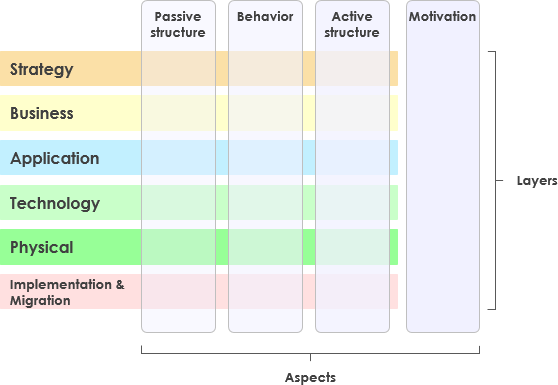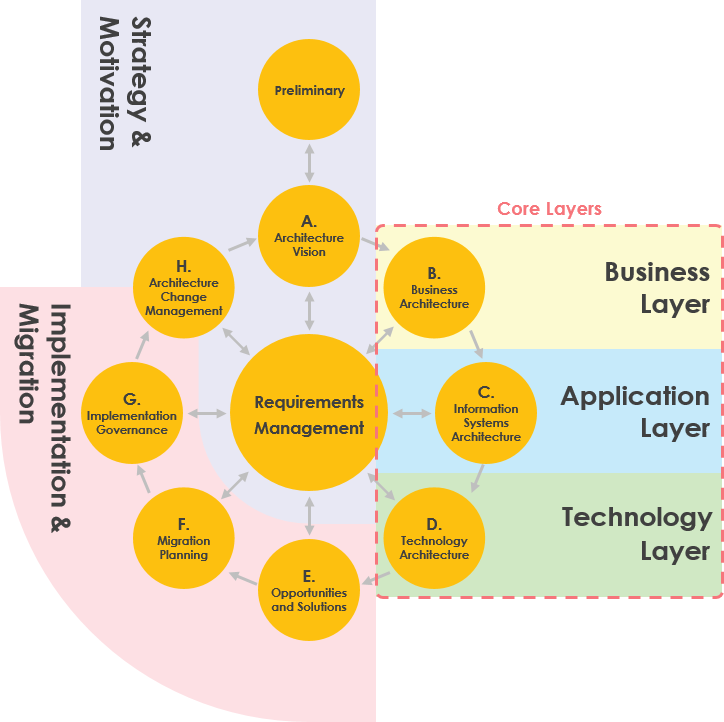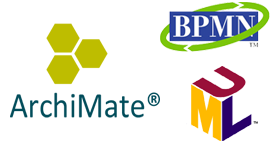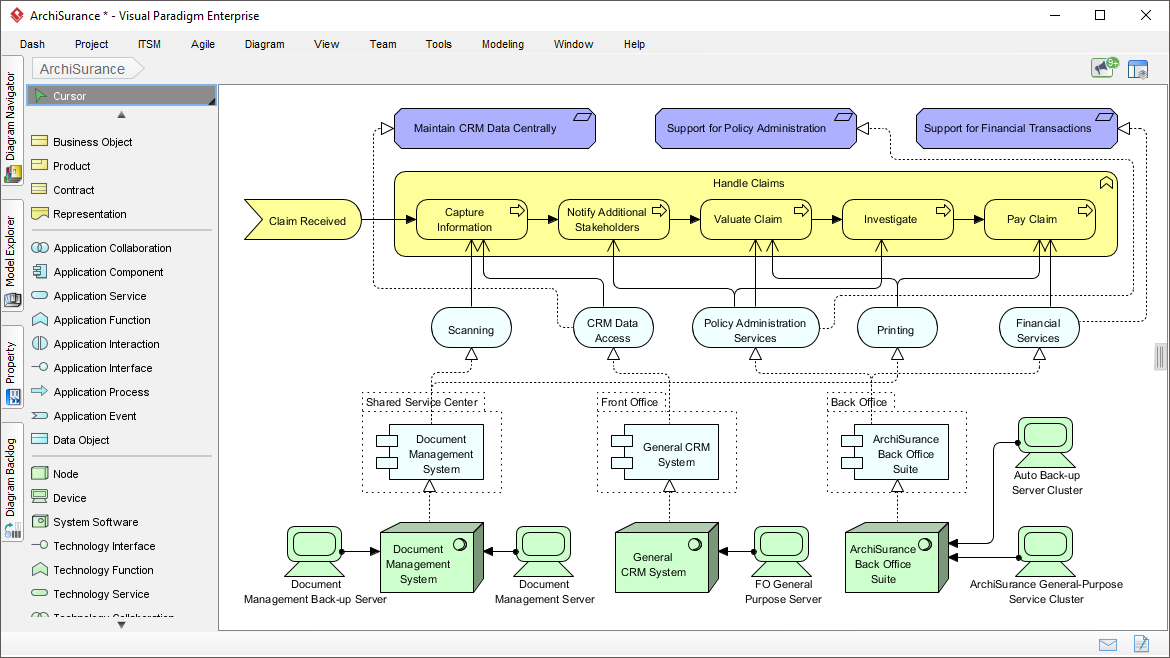What is ArchiMate
ArchiMate is a modeling language that supports the description, analysis, and visualization of enterprise architecture in a clear and unambiguous way. It is an open and independent standard from The Open Group, and is supported by various tool vendors and consulting firms. ArchiMate is designed to be used within and across business domains, and it is based on concepts from the now-superseded IEEE 1471 standard.

Unlike other modeling languages, such as Unified Modeling Language (UML) and Business Process Modeling and Notation (BPMN), ArchiMate is focused specifically on enterprise modeling. UML and BPMN contain a vast number of modeling concepts (around 150 for UML and 250 for BPMN), making them quite complex, while ArchiMate works with just around 50 concepts (in version 2.0). This deliberate simplification ensures that ArchiMate is easy to learn and apply, and that it covers the concepts necessary for modeling 80% of practical cases. The goal of ArchiMate is to be as streamlined as possible, rather than attempting to cover every edge scenario imaginable. The Open Group offers a certification program for ArchiMate users, software tools, and courses.
A Comprehensive Modeling Language for Enterprise Architecture
ArchiMate is a comprehensive modeling language that provides a common vocabulary for describing the construction and operation of business processes, organizational structures, information flows, IT systems, and technical infrastructure. By using this language, different stakeholders can design, assess, and communicate the consequences of decisions and changes within and between these business domains in a more effective manner.
The ArchiMate Framework can be viewed as a collection of main concepts and relationships that organize the enterprise architecture into three main layers: business, application, and technology. Each layer considers three aspects: active elements, an internal structure, and elements that define use or communicate information. By using this framework, architects can describe and understand the relationships between different architecture domains more easily and comprehensively.
The main objective of the ArchiMate language is to define the relationships between concepts in different architecture domains. The concepts used in this language are designed to be a middle ground between the detailed concepts used for modeling individual domains, such as the Unified Modeling Language (UML) for software product modeling, and Business Process Model and Notation (BPMN), which is used for business process modeling. This approach enables architects to model and communicate complex enterprise architectures in a more integrated and consistent manner.
Development and Evolution of ArchiMate: A Brief History
- ArchiMate is based on the IEEE 1471 standard and was developed in the Netherlands.
- It was created by a project team from the Telematica Instituut and partnered with several Dutch organizations from government, industry, and academia.
- Partners included Ordina, Radboud Universiteit Nijmegen, the Leiden Institute for Advanced Computer Science (LIACS), and the Centrum Wiskunde & Informatica (CWI).
- Organizations like ABN AMRO, the Dutch Tax and Customs Administration, and the ABP Pension Fund conducted tests on the language.
- The development process took place from July 2002 to December 2004, lasted about 35 person-years, and cost approximately 4 million euros.
- The development was funded by the Dutch government, the Dutch Tax and Customs Administration, and business partners like ABN AMRO and the ABP Pension Fund.
- The ownership and stewardship of ArchiMate was transferred to The Open Group in 2008, which is now managed by the ArchiMate Forum within The Open Group.
- The Open Group published the ArchiMate 1.0 standard in February 2009 and later released the ArchiMate 2.0 standard in January 2012 and the ArchiMate 2.1 standard in 2013.
- The Open Group released version 3.0 of the ArchiMate Specification in June 2016, followed by an update to ArchiMate 3.0.1 in August 2017.
- The latest version of ArchiMate is 3.1, which was published on November 5, 2019.
- ArchiMate 3.0 introduced enhanced support for capability-oriented strategic modelling, new entities representing physical resources, and a generic metamodel showing the entity types and relationships between them.
The Benefits of Learning ArchiMate: Who Should Consider It?
ArchiMate is a visual modeling language used to create enterprise architecture models. It is designed to help architects communicate complex architecture concepts in a clear and concise manner.
- ArchiMate provides a standardized visual modeling language for enterprise architecture, which can improve communication and collaboration between stakeholders.
- It offers a comprehensive framework for modeling different aspects of enterprise architecture, including business processes, applications, and technology infrastructure.
- ArchiMate models can be used to identify potential issues and gaps in enterprise architecture, and to help plan and prioritize changes and improvements.
- It supports integration with other enterprise architecture frameworks and standards, such as TOGAF, UML, and BPMN.
- ArchiMate models can be used to support decision-making and to provide a holistic view of enterprise architecture, which can be valuable for organizations in various industries.
- Learning ArchiMate can be a valuable skill for enterprise architects, IT professionals, and others involved in enterprise architecture, as it can enhance their knowledge and expertise in this field.
Anyone involved in enterprise architecture, such as enterprise architects, solution architects, business analysts, and IT managers, can benefit from learning ArchiMate. By learning ArchiMate, professionals can create more effective architecture models, make better-informed decisions, and communicate more clearly with stakeholders. Additionally, knowledge of ArchiMate can help professionals advance in their careers by demonstrating their expertise in enterprise architecture.
The ArchiMate Core Framework: Understanding the Main Concepts and Layers
ArchiMate is an open and independent Enterprise Architecture modelling language, designed to support the description, analysis and visualization of architecture within and across business domains. The ArchiMate Core Framework forms the backbone of the language and is used to represent the main concepts and elements of the language. It consists of three layers and three aspects, which combine to form a matrix of combinations.

The three main layers of the ArchiMate
The three main layers of the ArchiMate language are the Business layer, the Application layer, and the Technology layer. Each layer is focused on a specific aspect of the enterprise architecture.
The Business layer deals with business processes, services, functions, and events of business units, while the Application layer is concerned with software applications that support the components in the business with application services. The Technology layer is responsible for the hardware and communication infrastructure to support the Application Layer. This layer offers infrastructural services needed to run applications, realized by computer and communication hardware and system software. Each of these main layers can be further divided into sub-layers to provide more specific detail.
The three aspects of the ArchiMate
The three aspects of the ArchiMate language are the Passive structure, the Behavior, and the Active structure. The Passive structure is the set of entities on which actions are conducted. In the Business Layer, for example, this would be information objects, in the Application Layer data objects, and in the Technology Layer, it could include physical objects. Behavior refers to the processes and functions performed by the actors, while Active Structure is the set of entities that display some behavior, such as business actors, devices, or application components.
The ArchiMate Core Framework has a layered and service-oriented approach to architectural modelling. The higher layers make use of services provided by the lower layers. The concepts used within each layer are similar, but more concrete concepts are defined that are specific to each layer. The most important relationship between layers is formed by use relations, which show how the higher layers make use of the services of lower layers. Realization relations are also used, where elements in lower layers may realize comparable elements in higher layers.
Exploring the Enriched ArchiMate Full Framework
ArchiMate Full Framework is an extension of the ArchiMate Core Framework that provides a more comprehensive approach to modeling enterprise architecture. This framework includes additional layers and aspects that allow architects to represent physical equipment, materials, and distribution networks, as well as model a state of transition during implementation and migration.

- The Physical Layer is a new addition to the Full Framework and enables architects to represent physical elements in the architecture. This layer is particularly useful for modeling the infrastructure and hardware that supports the various software applications and services in an organization.
- The Implementation and Migration Layer provides a set of elements that allow architects to model the state of transition of an architecture during implementation and migration. This layer is essential for architects to mark parts of the architecture that are temporary and to keep track of the changes that occur during the transition phase.
- The Strategy Layer is another significant addition to the Full Framework and introduces elements that allow architects to incorporate a strategic dimension to the architecture. This layer includes elements such as Resource, Capability, and Course of Action that enable architects to model the usage of resources and capabilities in achieving strategic goals.
- The Motivation Aspect is the final addition to the Full Framework and allows different stakeholders to describe the motivation of specific actors or domains. This aspect includes elements such as stakeholder, value, driver, goal, and meaning, which are important when looking at an architecture from several different angles.
Overall, the ArchiMate Full Framework is a powerful modeling language that enables architects to create a more comprehensive representation of the enterprise architecture. It provides a more holistic view of the organization by incorporating physical elements, transition states, strategic goals, and motivational factors.
Benefits of Using ArchiMate for Architecture Visual Modeling
There are several benefits of using ArchiMate for architecture visual modeling:
- Improved communication: ArchiMate provides a standard notation for describing enterprise architecture, which helps in improving communication among stakeholders. This ensures that everyone understands the architecture and its implications.
- Comprehensive modeling: ArchiMate provides a comprehensive modeling language that covers all aspects of enterprise architecture, including business, application, and technology layers. This allows architects to create detailed models of their organization’s architecture.
- Better decision-making: ArchiMate models provide a better understanding of the organization’s architecture and how it supports the business goals. This helps decision-makers to make informed decisions about changes to the architecture.
- Integration with other modeling languages: ArchiMate can be integrated with other modeling languages, such as BPMN (Business Process Modeling Notation) and UML (Unified Modeling Language), to provide a more comprehensive modeling solution.
- Consistency and standardization: ArchiMate provides a standardized way of modeling enterprise architecture, which ensures consistency and standardization across the organization. This helps in maintaining the integrity and quality of the architecture.
- Scalability: ArchiMate models can be scaled up or down depending on the size of the organization and the complexity of the architecture. This allows architects to create models that are tailored to the needs of the organization.
Overall, ArchiMate helps organizations to create better architecture models, which ultimately leads to improved decision-making, better communication, and better alignment of business goals and IT strategies.
Integration of ArchiMate with Open Standards and TOGAF Framework
ArchiMate is designed to be used in conjunction with other open standards such as TOGAF, UML, and BPMN.
- TOGAF, the Open Group Architecture Framework, is a framework for enterprise architecture that provides a common language and methodology for developing and managing enterprise architecture. ArchiMate provides a modeling language that is specifically designed to support the principles and concepts of TOGAF, and is fully integrated with the framework.

- UML, the Unified Modeling Language, is a standard for visual modeling of software systems. ArchiMate is designed to be compatible with UML, and includes constructs for modeling software systems at an abstract level.
- BPMN, the Business Process Model and Notation, is a standard for visual modeling of business processes. ArchiMate includes constructs for modeling business processes at an abstract level, and is designed to be compatible with BPMN.

By integrating with these open standards, ArchiMate provides a comprehensive modeling language that can be used to model the full range of enterprise architecture artifacts, from high-level business processes to detailed software system components.
Recommended ArchiMate Tool
Visual Paradigm is a highly recommended commercial ArchiMate tool due to its user-friendly interface and extensive support for the ArchiMate language.

- One of its key advantages is its ability to generate reports and diagrams with ease, which is essential for effective communication with stakeholders.
- The tool also supports team collaboration, allowing team members to work on the same project simultaneously, which is a significant advantage for large-scale projects. Another notable advantage of Visual Paradigm is its ability to integrate with other development tools, such as TOGAF Guide-Through Process, which can streamline project management and facilitate the sharing of information.
- Finally, Visual Paradigm offers excellent customer support, including training and documentation, to ensure that users can fully leverage the tool’s capabilities.
Overall, these features make Visual Paradigm a highly recommended tool for ArchiMate modeling, and an excellent choice for businesses looking for a comprehensive and easy-to-use solution.
ArchiMate References
- Full ArchiMate Viewpoints Guide (Examples Included)
- Free Online ArchiMate Diagram Tool
- ArchiMate Resources for FREE
- Best ArchiMate Software
- Archimate Diagram Templates
- ArchiMate examples

